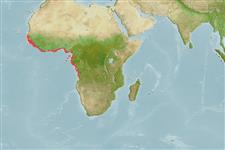Common names from other countries
Environment: milieu / climate zone / depth range / distribution range
Ecología
Bentopelágico; salobre; rango de profundidad 3 - 740 m (Ref. 105050). Tropical; 16°N - 17°S, 18°W - 14°E
Distribución
Países | Áreas FAO | Ecosistemas | Ocurrencias, apariciones | Introducciones
Eastern Atlantic: along West African coast, from Senegal to Angola.
Length at first maturity / Tamaño / Peso / Age
Maturity: Lm ? range ? - ? cm Max length : 7.5 cm TL macho / no sexado; (Ref. 434)
Pelagic (Ref. 105112). Exploited in the continental shelf (Ref. 121688). Inshore, prefers high salinity river mouths (Ref. 121669). Also found on sandy and muddy bottoms in estuarine and coastal marine waters to depths of about 50 m (Ref. 434). Mainly feeds on mysids and copepods. Preyed upon by fish and decapods (Ref. 105112).
Life cycle and mating behavior
Madurez | Reproducción | Puesta | Huevos | Fecundidad | Larva
Members of the order Decapoda are mostly gonochoric. Mating behavior: Precopulatory courtship ritual is common (through olfactory and tactile cues); usually indirect sperm transfer.
Fischer, W., G. Bianchi and W.B. Scott (eds.). 1981. (Ref. 434)
IUCN Red List Status (Ref. 130435)
CITES status (Ref. 108899)
Not Evaluated
Not Evaluated
Human uses
Pesquerías: comercial
FAO - pesquerías: landings | FishSource |
Herramientas
Fuentes de Internet
Estimates based on models
Preferred temperature
(Ref.
115969): 11 - 16.4, mean 14.2 (based on 40 cells).
Vulnerability
Low vulnerability (10 of 100).
